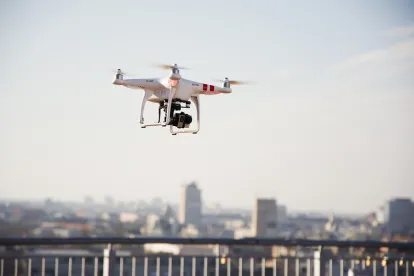The Federal Aviation Administration (FAA) recently issued a final rule to regulate the commercial use of small unmanned aircraft or drones.[1] Some of the requirements of the final rule could preclude the use of drones for the efficient monitoring and inspection of remote and linear energy facilities such as transmission lines, pipelines and hydroelectric facilities. Congress, however, has instructed the FAA to develop procedures to exempt from those requirements the use of drones for monitoring and inspection of critical infrastructure.
This Alert provides an overview of the requirements with which drone operators must comply in order to legally operate a drone. It also provides a brief explanation of the steps that utilities, pipelines and their contractors must take in order to operate drones for monitoring and inspection operations on critical infrastructure facilities.
Background
The FAA Modernization and Reform Act of 2012 directed FAA to develop a comprehensive plan to integrate the use of drones into the national airspace and to develop regulations to implement that plan. Accordingly, on June 28, 2016, the FAA issued the “Small Unmanned Aircraft Rule” to allow for routine civil operation of small drones for non-recreational purposes and to establish a comprehensive set of rules for those operations.[2] This rule, which becomes effective on August 29, 2016, adds a new Part 107 to Title 14 of the Code of Federal Regulations and replaces existing FAA regulations related to airworthiness, airman certification and operating limits.
The rule promulgates a number of specific requirements that must be met by any person seeking to operate a drone for purposes of monitoring, surveying and / or inspecting energy infrastructure facilities. Those include requirements that the drone–
-
must be registered with the FAA, a process that can be completed online if the drone will only be used within the territorial United States;
-
may only be operated by a person with a remote pilot certification issued by the FAA;
-
may not be operated over human beings not participating in the operation;
-
may not be operated under a covered structure or inside a stationary vehicle;
-
stay within 400 feet of ground level or a structure;
-
remain within the visual line-of-sight of the remote pilot or visual observer; and,
-
may be operated only during daylight or twilight (within 30 minutes of sunrise or sunset) hours.
Fast on the heels of this rulemaking, the FAA Extension, Safety, and Security Act of 2016 was passed by the Congress and signed into law on July 15.[3] Section 2210 of this Act requires the FAA to establish an application process for the use of drones for monitoring, surveying and inspection of critical infrastructure facilities during the day or at night and beyond the line-of-sight of the individual operating the drone. Critical infrastructure facilities include oil and gas production, storage, transportation, and delivery systems; electric generation, transmission, and distribution facilities; water supply systems; telecommunications networks; and transportation systems and services.
Drone uses that are permitted under Section 2210 include activities to ensure compliance with Federal or State regulatory, permit, or other requirements; activities to inspect, repair, construct, maintain, or protect critical infrastructure facilities, including for the purpose of responding to an incident; and, activities in response to or in preparation for a natural disaster, manmade disaster, severe weather event, or other incident beyond the control of the applicant. In addition, Section 2210 specifically authorizes the use of drones at night and beyond the visual line of sight of the remote pilot.
Section 2210 requires the FAA to certify to the Congress by October 15 that it has established an application process for drone operations for the critical infrastructure activities described above. The FAA has not yet established such an application process and it is unclear if or when the agency will do so. However, the FAA informally has advised that, in the absence of an application process to carry out Section 2210, it intends to utilize the Part 107 “certificate of waiver” process to waive any requirements that may limit or prevent the use of drones for purposes identified in Section 2210. Under this process, the FAA may issue a waiver authorizing deviation from some of the Part 107 requirements if it determines that a proposed drone operation “can safely be conducted under the terms of the waiver.”
Steps Necessary to Acquire Authorization to Operate a Drone
While the new FAA regulations provide for fairly non-intrusive oversight of drone use, an applicant seeking authorization to operate a drone consistent with Part 107 and Section 2210 will need to:
-
register its drone with the FAA;
-
ensure that its pilot has a remote pilot certification;
-
apply for any necessary waivers from the requirements of Part 107 and demonstrate that the drone can be safely operated under the terms of the waiver; and
-
demonstrate that it is in compliance with the remainder of the requirements of Part 107.
These requirements include rules for aircraft maintenance and inspection; operating limitations relating to types of airspace, awareness of prohibited areas, speed, altitude, visibility, and location of persons and property; emergency procedures, contingency procedures, and consideration of potential hazards; and reporting requirements for deviation from the rules of part 107 in the event of emergency.
After acquiring authorization to operate a drone, the applicant will need to ensure that it has systems in place to ensure continuing compliance with these requirements.
In summary, any entity seeking to operate drones for monitoring, surveying, and inspecting critical infrastructure facilities, will need to complete two general steps –
-
apply to FAA to register the drone, acquire certification of the remote pilot, and seek any needed waivers; and,
-
establish an internal system to ensure and demonstrate that the registered drone will be and is being operated in a manner that complies with the requirements of Part 107.
[1] The final rule is applicable to “small unmanned aircraft systems”. In this Alert, we use the more common term “drone” to refer to the small unmanned aircraft subject to the final rule.
[2] Operation and Certification of Small Unmanned Aircraft Systems, 81 Fed. Reg. 42,064 (June 28, 2016) (to be codified at 14 C.F.R. pts. 21, 43, 61, 91, 101, 109, 119, 133, and 183).
[3] FAA Extension, Safety, and Security Act of 2016, Pub. L. No. 114-190, 130 Stat. 615.






 />i
/>i

